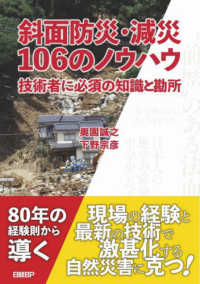Full Description
This book introduces the concept of novel process windows, focusing on cost improvements, safety, energy and eco-efficiency throughout each step of the process. The first part presents the new reactor and process-related technologies, introducing the potential and benefit analysis. The core of the book details scenarios for unusual parameter sets and the new holistic and systemic approach to processing, while the final part analyses the implications for green and cost-efficient processing. With its practical approach, this is invaluable reading for those working in the pharmaceutical, fine chemicals, fuels and oils industries.
Contents
Motivation Who should read the book!? XVII Acknowledgments XIX Abbreviations XXI Nomenclature XXIII 1 FromGreen Chemistry to Green Engineering Fostered by Novel ProcessWindows Explored in Micro-Process Engineering/Flow Chemistry 1 1.1 Prelude Potential for Green Chemistry and Engineering 1 1.2 Green Chemistry 2 1.2.1 12 Principles in Green Chemistry 2 1.3 Green Engineering 3 1.3.1 10 Key Research Areas in Green Engineering 3 1.3.2 12 Principles in Chemical Product Design 4 1.4 Micro- and Milli-Process Technologies 6 1.4.1 Microreactors 6 1.4.2 Microstructured Reactors 6 1.5 Flow Chemistry 9 1.5.1 10 Key Research Areas in Flow Chemistry 9 1.6 Two Missing Links Cross-Related 9 References 12 2 Novel ProcessWindows 15 2.1 Transport Intensification The Potential of Reaction Engineering 15 2.2 Chemical Reactivity in Match or Mismatch to Intensified Engineering 17 2.3 Chemical Intensification through Harsh Conditions Novel Process Windows 18 2.4 Flash Chemistry 19 2.5 Process-Design Intensification 21 References 23 3 Chemical Intensification Fundamentals 25 3.1 Length Scale 25 3.2 Time Scale 26 3.3 Length and Time Scale of Chemical Reactions 28 3.3.1 Solution of Kinetic Equations 29 3.3.2 Reaction Time and Reaction Classification 31 3.3.3 Example for Reaction Time and Residence Time 32 3.4 Temperature Intensification 33 3.4.1 Harsh Process Conditions 33 3.4.2 New TemperatureWindows 33 3.4.3 Reaction Rate Arrhenius Equation 35 3.5 Pressure Intensification 36 3.5.1 Reaction Rate Activation Volumes 36 3.5.2 Equilibrium 37 3.5.3 Electron Kinetic Energy 38 3.5.4 Material Properties 38 3.5.5 Mixture Properties 40 3.5.6 Illustration of Pressure Effect on Selected Chemical Reactions 41 References 42 4 Making Use of the Forbidden Ex-Regime/High Safety Processing 45 4.1 Hazardous Reactants and Intermediates 45 4.1.1 Tetrazole Formation 45 4.1.2 Strecker Synthesis 47 4.1.3 Phosgene Chemistry 47 4.1.4 Diazomethane Synthesis 48 4.1.5 Ozonolysis 50 4.1.6 Organic Peroxide Formation 51 4.2 Ex-Regime andThermal Runaway Processing 52 4.2.1 Oxidation 52 4.2.2 Hydrogen Peroxide Synthesis 52 4.2.3 Direct Fluorination 53 4.2.4 Ionic Liquid Synthesis 53 4.2.5 Moffatt Swern Oxidation 54 4.2.6 Reaction Between Cyclohexanecarboxylic Acid and Oleum 55 4.2.7 Nitration of Toluene 55 4.2.8 Aromatic Amidoxime Formation 56 4.2.9 Decarboxylative Trichloromethylation of Aromatic Aldehydes 56 4.2.10 Dihydroxylation Reactions with Nanobrush-Immobilized OsO4 58 References 58 5 Exploring New Paths New Chemical Transformations 61 5.1 Direct Syntheses via One Step 61 5.1.1 Fluorination with Elemental Fluorine 61 5.1.2 Hydrogen Peroxide Synthesis out of the Elements 62 5.1.3 Direct Aryllithiums Route 62 5.1.4 C O Bond Formation by a Direct -C H Bond Activation 63 5.1.5 Direct Adipic Acid Route from Cyclohexene 65 5.1.6 New Biocatalytic Pathways without Protecting Groups Inter-Glycosidic Condensation 68 5.2 Direct Syntheses via Multicomponent Reactions 69 5.2.1 Odor-Sealed Isocyanide Formation 69 5.3 Multistep One-Flow Syntheses 70 5.4 Multistep Syntheses in One Microreactor/Chip 73 5.4.1 Multistep Synthesis of [18F]-Radiolabeled Molecular Imaging Probe 73 5.4.2 Combining Asymmetric Organocatalysis and Analysis on a Single Microchip 75 5.4.3 Two-Step Strecker Reaction 75 5.5 Multistep Syntheses in Coupled Microreactors/Chips 76 5.5.1 Chlorohydrination of Allyl Chloride 76 5.5.2 Lithiation/Borylation/Suzuki Miyaura Cross-Coupling 77 5.5.3 Suzuki Miyaura Cross-Coupling-Phenols-Aryl Triflates-Biaryls 77 5.5.4 Ring-Closing Metathesis and Heck Reaction 77 5.5.5 Imidazo[1,2-a]pyridine-2-carboxylic Acids in Two Steps 78 5.5.6 Suzuki Miyaura Cross-Coupling/Hydrogenation 78 5.5.7 Sodium Nitrotetrazolate Diazonium Ion Formation/Sandmeyer Reaction 79 5.5.8 Murahashi Coupling/Br Li Exchange 79 5.5.9 5 -Deoxyribonucleoside Glycosylation 80 5.5.10 Two-Carbon Homologation of Esters to , -Unsaturated Esters 81 5.5.11 Low-Pressure Carbonylations with Acids as CO Precursors 81 5.5.12 Coupled Microreactor-Purification-Analytics for -Opioid Receptor Agonist 82 5.5.13 Synthesis of TAC-101 Analogs 82 5.5.14 Multistep Enzymatic Synthesis to 2-Amino-1,3,4-Butanetriol 83 5.5.15 Multistep Enzymatic Synthesis to -D-Gluconolactone 83 5.5.16 Diarylethene Synthesis in Two Steps 87 References 87 6 Activate High-T Processing 91 6.1 Tailored High-T Microreactor Design and Fabrication 93 6.1.1 Glass Capillary Coil in Ceramic Housing 93 6.1.2 Modularly Packaged Silicon Microreactor 93 6.1.3 Modular Thermal Platform for High-Temperature Flow Reactions 93 6.2 Cryogenic to Ambient Allowing Fast Reactions to be Fast 94 6.2.1 Synthesis of Triflates for the Heck Alkenylation 94 6.2.2 Enantioselective 1,4-Addition of Enones 96 6.2.3 Swern Moffatt Oxidation of Benzyl Alcohol 97 6.2.4 Tf2NH-Catalyzed [2+2] Cycloaddition 98 6.3 From Reflux to Superheated Speeding-Up Reactions 99 6.3.1 Kolbe Schmitt Reaction 99 6.3.2 C F Bond Formation 99 6.3.3 NMP Radical Polymerization of Styrene 100 6.3.4 Noncatalytic Claisen Rearrangement 100 6.3.5 Nucleophilic Substitution of Difluoro-benzenes 100 6.3.6 Aminolysis of Epoxides 101 6.3.7 Synthesis of 2,4,5-Trisubstituted Imidazoles 102 6.3.8 2-Methylbenzimidazole Formation, 3,5-Dimethyl-1-Phenylpyrazole Formation, and Diels Alder Cycloaddition Benchmarking High-p,t Flow to Microwave 102 6.3.9 Fischer Indole Synthesis of Tetrahydrocarbazole 103 6.3.10 Thermal Hydrolysis of Triglycerides 103 6.3.11 Chlorodehydroxylation to n-Alkyl Chlorides 104 6.3.12 1,3,4-Oxadiazoles via N-Acylation of 5-Substituted Tetrazoles 105 6.3.13 Cobalt-Catalyzed Borohydride Reduction of Tetralone 106 6.3.14 Dimethylcarbonate Methylation 107 6.3.15 Selective Aerobic Oxidation of Benzyl Alcohol Using Iron Oxide Nano-/TEMPO Catalyst 108 6.3.16 Rufinamide Synthesis 110 6.3.17 Several High-T, High-p Processes 111 6.3.18 Click Chemistry 111 6.3.19 4-(Pyrazol-1-yl) Carboxanilide Multistep Synthesis 112 6.3.20 4-Hydroxy-2-cyclopentenone Synthesis 113 6.3.21 Hydrothermal Treatment of Glucose 114 6.3.22 Tetrahydroisoquinoline Synthesis 114 6.4 Solvent-ScopeWidening by Virtue of Pressurizing Existing High-T Reactions 116 6.4.1 Nucleophilic Aromatic Substitution of 2-Halopyridines 116 6.4.2 IntramolecularThermal Cyclization and Benzannulation 116 6.4.3 Catalyst-Free Transesterification and Esterification of Aliphatic and Aromatic Acids 117 6.4.4 Aminolysis of Epoxides 117 6.5 New Temperature Field for Product and Material Control 118 6.5.1 Palladium-Catalyzed Aminocarbonylation 118 6.5.2 Aminolysis of Epoxides 119 6.5.3 Flash Flow Pyrolysis 119 6.5.4 Indium Phosphide Nanocrystal 120 6.5.5 Quantum Dot Synthesis 121 6.5.6 High-T Flow Cycloaddition to Fullerene Derivatives 123 6.6 Energy Activation Other than Temperature Photo, Electrochemical, Plasma 125 6.6.1 Photo-Oxygenation of Dimethylsulfide 125 6.6.2 Microwave Flow Reactor for Stable High-p,T Operation 125 References 125 7 Press High-p Processing 129 7.1 Tailored High-p Microreactor Design and Fabrication 129 7.1.1 Solder-Based Silicon Microsystem 129 7.1.2 In-Plane Fiber-Based Interfaced Microreactor 129 7.2 High Pressure to Intensify Interfacial Transport in Gas Liquid Reactions 130 7.2.1 Hydrogenation of Cyclohexane 130 7.2.2 Carbamic Acid Formation 130 7.2.3 Intramolecular Aldol Condensation to 1-Methyl-1-cyclopenten-3-one 131 7.2.4 Catalytic Hydrogenation of Acetone 131 7.2.5 Propylene Oxide Synthesis 132 7.2.6 Asymmetric Amino-2-indanol Hydrogenation 132 7.2.7 Hydrogen Gas Liquefication in Guaiacol Conversion (hydroprocessing) 132 7.3 Pressure as Direct Means Activation Volume Effects and More 133 7.3.1 Claisen Rearrangement 133 7.3.2 Nucleophilic Aromatic Substitution ofThree p-Halonitrobenzenes 133 7.3.3 Diels Alder Reaction with Furylmethanols and Cyclopentadiene 134 7.3.4 Aza Diels Alder Reaction 136 7.3.5 Esterification of Phthalic Anhydride 136 7.4 Pressure for Advanced Fluidic Studies to be Used for Shaping Materials and More 137 7.4.1 scCO2 Droplets or Jets in LiquidWater 138 References 138 8 Collide and Slide High-c and Tailored-Solvent Processing 141 8.1 Batch Process-Based Inspirations for High-c Flow Processes 141 8.1.1 Polypropylene and Polycarbonate Polymerizations 141 8.1.2 EnantioselectiveThermal and Photochemical Solid-State Reaction 142 8.2 Solvent-Free or Solvent-Less Operation Highest-c 142 8.2.1 Bromination of 3-Bromo-imidazo[1,2-a]Pyridine 142 8.2.2 Thiophene Bromination 142 8.2.3 Claisen Rearrangement of Substituted Phenyl Phenols 142 8.2.4 Michael Addition 143 8.2.5 Peroxidation of Methyl Ethyl Ketone 144 8.2.6 Beckmann Rearrangement (High-c) 144 8.2.7 [2+2] Photocycloaddition of a Chiral Cyclohexenone (High-c) 145 8.2.8 Bromination of Toluene (Solvent-Free) 148 8.2.9 Sulfonation of Nitrobenzene (Solvent-Free) 148 8.2.10 Synthesis of Nitro Herbicides (High-c, Solvent-Free) 148 8.2.11 Suzuki Miyaura Reaction over Sol Gel Entrapped Catalyst SiliaCat DPP-Pd 150 8.2.12 Enzyme and Coenzyme (High-c in Bioprocessing) 150 8.2.13 Enzyme and Coenzyme (High-c in Bioprocessing) 151 8.3 Supercritical Fluids to Combine the Former Separated Mass Transfer Boost 152 8.3.1 Supercritical Hydrogenation of Cyclohexene 155 8.3.2 Supercritical Hydrogenations of Double and Triple Bounds 155 8.3.3 Ascaridole Synthesis under Photo-Supercritical Conditions 157 8.3.4 Citronellol Oxidation under Photo-Supercritical Conditions 157 8.3.5 Near-scCO2 Enzymatic Biodiesel Synthesis 157 8.3.6 SupercriticalWater, Non-Catalytic Beckmann Rearrangement 158 8.3.7 SupercriticalWater, Non-Catalytic Pinacol Rearrangement 159 8.3.8 SupercriticalWater Oxidation 159 8.3.9 Supercritical-Acetonitrile, Nitriles from Carboxylic Acids 162 8.3.10 Self-Optimizing Continuous Reactions under Supercritical Conditions 162 References 163 9 Doing More by Combining Process Integration 165 9.1 Integration of Reaction and Cooling/Heating, Separation, or Other 165 9.1.1 Integrated Micro-Steam Reformer-Catalytic Combustor for Methane Fuel Processing 165 9.1.2 Integrated Microburner/Thermoelectric Device for System Start-Up 166 9.1.3 Integrated Micro Reactor Evaporative Cooler 167 9.1.4 Integrated Microwave Microreactor 167 9.1.5 Integrated Enzyme Microreactor Extractor 167 9.1.6 Integrated Membrane Microreactor for Knoevenagel Reaction 168 9.1.7 Continuous Multiple Liquid Liquid Separation: Diazotization of Amino Acids 169 9.1.8 Coupling of the Hydroxylation of Progesterone Using Rhizopus Nigricans with Flow Extraction 169 9.1.9 Coupling of the Esterification to Isoamyl Acetate Using Lipase B with Flow Extraction 170 9.2 Integration of Process Control and Sensing 171 9.2.1 Integrated Process Control for Methanol Steam Reforming 171 9.2.2 Integrated Sensing, Catalyst, and Heating for Ammonia Oxidation 171 9.2.3 Integration of the Esterification to Ethyl Oleate Using Lipase B with Photoionization Mass Spectrometry 172 9.2.4 Integration of the Intramolecular Friedel Crafts Addition with Ultra-High-Pressure Liquid Chromatography 173 9.2.5 Integration of Pyrane Flow Reaction and Synchrotron-Based IR and X-Ray Beam Analysis 174 9.2.6 Integration of Multistep Organic Transformations Catalyzed by Au Nanoclusters 176 9.3 Thermal Integration on a Process Level 177 9.3.1 Thermal Integration of a Methanol Micro-fuel Processor/Fuel Cell 177 9.4 Integration of Units on Racks, Backbones, Frames, Interfaces, or Similar Level 178 9.4.1 Integrated Circuit Socket for Fluidic-Electric Interface 178 9.4.2 Chassis-Type Unit Racking and System Automation 178 9.4.3 Modularization of (Flow) Plant Equipment 179 9.4.4 Modular Gas Liquid Microreactor 179 9.5 Fully Intensified/Flow Process Development 179 9.5.1 Adipic Acid Large-Scale Manufacture 179 References 183 10 Doing the Same with Less Process Simplification 185 10.1 Omitting the Use of a Catalyst 185 10.1.1 Air Oxidation of Cyclohexane 185 10.1.2 Bromination of Toluene 185 10.1.3 Tetrazole Click Chemistry 186 10.2 Simplifying Separation 186 10.2.1 Phenyl Boronic Acid Synthesis 187 10.2.2 Simplifying Operation 188 10.2.3 Trans-1,2-Cyclohexanediol Exothermic Steps Done All-in-Once 188 10.2.4 Olefin Autoxidation 189 References 190 11 Implications of NPW to Green and Cost Efficient Processing 191 11.1 Introduction 191 11.2 Knowledge-Based Design of Future Chemistry Coupling the Implementation of NPWwith Evaluation and Decision Support Tools 192 11.3 Evaluation Methods 192 11.3.1 Single Metrics 193 11.3.2 Holistic Approaches 194 11.3.3 Life Cycle Costing 201 11.3.3.1 Cradle-to-Gate Approach in LCC 202 11.3.3.2 Calculation of Costs 204 11.3.3.3 Separation of Costs in Variable and Fixed Costs 206 11.3.4 Summary of Life Cycle-Based Evaluation Methods 206 11.4 Evaluation of the NPWConcept Impact on Sustainability 206 11.4.1 Evaluation of New Chemical Transformations 207 11.4.1.1 One-Pot Multistep Synthesis of Fine Chemicals 207 11.4.1.2 Avoidance ofWaste Products 207 11.4.2 Evaluation of High-Temperature, High-Pressure Operation 208 11.4.2.1 p-Xylene Partial Oxidation under Harsh Conditions 208 11.4.2.2 Process Intensification of Biodiesel Generation 209 11.4.2.3 Generation of Carbon Nanotubes at High Temperatures 211 11.4.2.4 Activation of Carbon Dioxide 213 11.4.2.5 Impact of Harsh Process Conditions of Catalyst Deactivation 215 11.4.2.6 Methane Decomposition at High Reaction Temperatures 216 11.4.2.7 Synthesis of Fullerenes by Pyrolysis versus Plasma 217 11.4.2.8 Epoxidation Reaction at Accelerated Temperature 219 11.4.2.9 Trade-Off Designs for a Hydrocarbon Biorefinery 220 11.4.3 Reduction and Replacement of Solvents 222 11.4.3.1 Sildenafil Citrate Process 222 11.4.3.2 Suzuki Miyaura Cross-Coupling 224 11.4.3.3 Synthesis and Application of Ionic Liquids 225 11.4.4 Evaluation of Process Integration 226 11.4.4.1 Acceleration of Multiphase Reactions via Ultrasound 226 11.4.4.2 Process Optimization of a Pharmaceutical Synthesis 229 11.4.4.3 Process Simplification of Adipidic Acid Synthesis 231 11.4.4.4 Process Enhancement via Phase Transfer Catalysis 232 11.4.4.5 Separate Step versus Coproduction for Methanol Production 234 11.4.4.6 Process Integration in Terms of Costs 234 11.4.4.7 The Effects of Modular Plants 235 11.5 Future Environmental and Economic Sustainability Evaluation in the Context of Flow-Chemistry under NPWConditions 236 References 238 12 From Milligrams to Kilograms Scale-Up in Modular Flow Reactors 241 12.1 Reactor Types 241 12.2 Scale-Up Parameters 243 12.2.1 Geometry 244 12.3 Numbering-Up 246 12.3.1 Internal Numbering-Up 246 12.3.2 External Numbering-Up 246 12.4 Single-Channel Operation 247 12.4.1 Fluid Dynamics in a Rectangular Channel 247 12.4.2 Mean Residence Time and Its Distribution 248 12.4.3 Pressure Loss and Mixing 252 12.4.4 Heat Transfer in Channel Reactors 254 12.4.5 Parametric Sensitivity and Reactor Thermal Stability 256 12.5 Methodology for Continuous-Flow Process Development 258 12.5.1 General Chemical Plants and Modular Setup 261 12.5.2 Platform Concept and Scalability 264 12.5.3 Modular Process Development 267 12.5.3.1 Module A: Feasibility Study Milestone Decision 268 12.5.3.2 Module B: Process Synthesis and Optimization Milestone Decision 270 12.5.3.3 Module C: Process Robustness and Economy Milestone Decision 273 12.5.3.4 Module D: Pilot Production and Commercial Manufacturing 274 12.6 Conclusions 278 References 280 13 Evolution of Novel ProcessWindows 283 13.1 Multifaceted Novel ProcessWindows: Evolution 283 13.1.1 Novel Chemistry Liberation of Chemical Potential (2005) 283 13.1.2 NPW-Route Classification and Experimental Demonstration (2009) 283 13.1.3 NPW-Reaction Compilation Out of One Source 1 (2010) 284 13.1.4 NPW-Reaction Compilation Out of One Source 2 (2010) 284 13.1.5 Flow Chemistry High-T Overview Superheated Processing (2010) 284 13.1.6 Flow Chemistry High-T Overview from-Cryo-to-Ambient Processing 285 13.1.7 NPW-Methodology and Intensification Considerations for High-T Flow Reactions (2011) 285 13.2 High-p,T Commercial Flow Chemistry Equipment 286 13.3 Funding Agency Initiatives 286 13.3.1 DBU Cluster Novel ProcessWindows 287 13.3.2 EU Funding 289 References 291 14 Scientific Dissemination of Novel ProcessWindows 293 14.1 Literature Share for Chemical Intensification 293 14.1.1 Search Methodology and Limitations 293 14.1.2 High-Temperature, High-Pressure, High-Concentration in Chemistry and Chemical Engineering Literature 294 14.1.3 High-T, -p, -c in Microreactor Literature 295 14.1.4 High-(T, p, c) and NPWImportance in Current Microreactor and Overall Literature 298 14.2 Literature Share for Process-Design Intensification 298 References 300 15 Outlook 301 15.1 Process Automation 301 15.1.1 Computer-Controlled Flow Processing 301 15.1.2 Process-Automated Application Example 301 15.2 Means of Activation Other than High-Temperature, High-Pressure, High-Concentration, and High-Solvent 303 15.2.1 Photoactivation 303 15.2.2 Activation by Instable Catalyst Precursors 305 References 307 Index 309








